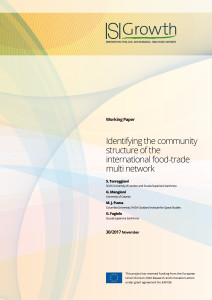Achieving international food security requires improved understand- ing of how international trade networks connect countries around the world through the import-export flows of food commodities. The properties of food trade networks are still poorly documented, especially from a multi-network perspective. In particular, nothing is known about the community structure of food networks, which is key to understanding how major disruptions or “shocks” would impact the global food system. Here we find that the individual layers of this network have densely connected trading groups, a consistent characteristic over the period 2001 to 2011. We also fit econometric models to identify social, economic and geographic factors explaining the probability that any two countries are co-present in the same community. Our estimates indicate that the probability of country pairs belonging to the same food trade community depends more on geopolitical and economic factors – such as geographical proximity and trade agreements co-membership – than on country economic size and/or income. This is in sharp contrast with what we know about bilateral-trade determinants and suggests that food country communities behave in ways that can be very different from their non-food counterparts.
Identifying the community structure of the international food-trade multi network
SOAS University of London and Istituto di Economia, Scuola Superiore Sant’Anna
Giuseppe Mangioni
Dipartimento di Ingegneria Elettrica, Elettronica e Informatica, University of Catania
Michael Joseph Puma
Center for Climate Systems Research and Center for Climate and Life, Columbia University; NASA Goddard Institute for Space Studies, New York
Giorgio Fagiolo
Istituto di Economia, Scuola Superiore Sant’Anna

